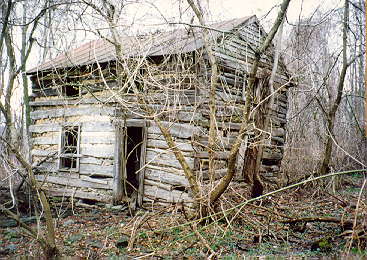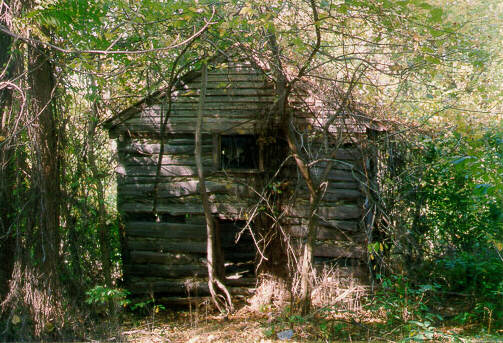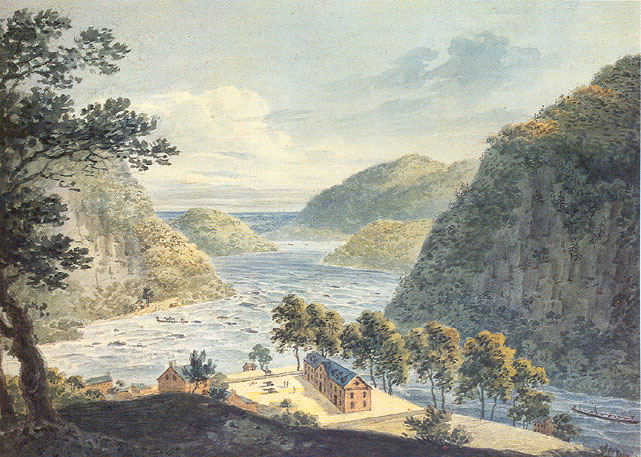This web site and related links provide archaeological and historical research concerning 18th and 19th century sites in Harpers Ferry, West Virginia, and nearby Loudoun Valley, Virginia, as well as the broader region of the upper Potomac and northern Shenandoah Valleys. The author is an anthropologist and lawyer (MA, U. Penn., 1986; JD, Georgetown, 1989; PhD, U. Va., 2003), with research interests in historical archaeology, American history, and African diaspora studies. |
| | Excavations & Research | |
| In the summer of 1999, I conducted a six-week field school, through the Department of Anthropology at the University of Virginia, on "Field Methods in Historical Archaeology." Students participated in excavating a house site dating from the late eighteenth century onward (see images below) in northern Loudoun County, Virginia, located just a few miles south of Harpers Ferry, at an elevation of several hundred feet in the Short Hill Mountains. These excavations were part of my larger study, entitled Consuming Mosaics, designed to explore the lifeways of residents at such remote farmsteads and the degree to which they were impacted by waves of immigrant settlers and growing economies of mass produced goods in this backcountry region of the upper Potomac River Valley in the eighteenth and nineteenth centuries. This course provided students with an introduction to the field methods utilized in conducting archaeological investigations of historic period sites. We covered topics including excavating, surveying, mapping, recording, artifact analysis, and related documentary analysis. We excavated over 30 units and over 100 shovel test pits, and recovered over 20,000 artifacts, including parts of a nineteenth century percussion rifle, a variety of ceramics, bottle glass, tools, toys, potential gaming pieces, sewing implements, clothing remains, floral and faunal remains, an artifact of folk religion practices, and hand-wrought and machine-made iron wares.  Late 18th-Century Upland House Site, South View This excavation was part of a regional study that addresses the unfolding and interaction of three cultural processes in the upper Potomac and northern Shenandoah region surrounding Harpers Ferry, West Virginia, during the period of 1750 to 1865. One process involved the dynamics with which distinct social groups and networks formed, solidified and dissipated over time. Such social group dynamics included a second process of communication through the stylistic shaping and display of material culture. These two processes in turn impacted a third set of dynamics that involved regional exchange systems and competing socio-economic interests deployed across the North Atlantic and within the mid-Atlantic region of America. I explore the ways in which these three processes intersected one another as members of varying social groups created, obtained, used, and displayed objects, including manufactured goods, that exhibited stylistic patterns that could be employed to communicate a consumer's affiliations with those groups. The questions I pursue in this study were first motivated by my archaeological and historical investigations of this household site in Loudoun County, Virginia. A standing shell of this small log house, which was built in the late 1700s or early 1800s, presented me with puzzling facets of material culture. The house stood on property that had been leased in the late 1700s and then purchased in 1811 by a family named Demory. Members of the Demory family were of German-American heritage and worked as farmers. They also owned one to two enslaved African Americans at various times during the antebellum. Various forms of material culture at that site raised questions of the degree to which objects and dwellings can be distinctly shaped by stylistic and symbolic traditions associated with particular ethnic groups. In my first excavations at the site in 1997, I uncovered a small, sculpted figure from beneath the house floor that was associated with other artifacts dating within the period of 1780 to 1860. This object was sculpted in the form of a human skull and bore inscriptions of four initials and a cross-line motif that indicated it was likely created pursuant to a system of religious and cosmological beliefs. After further research, the attributes of that sculpted figure appeared to provide evidence that an African-American person who lived or worked at this site may have created this object, composing its design pursuant to beliefs and practices derived from the BaKongo culture of West Central Africa. Key attributes of the object were similar to those found on artifacts uncovered at other eighteenth and nineteenth-century African-American sites in North America. Thus, a very local puzzle fit into a broader subject reaching to other sites in the Americas and to a trans-Atlantic diaspora of particular African traditions.  Upland House Site, Loudoun Valley, East View The trans-Atlantic movement and development of another set of cultural traditions also presented itself through this small house in Loudoun. The multiple attributes of the small, sculpted figure can be explained to a large extent as the product of an African-American cultural tradition. However, this interpretation cannot account for two of the four initials inscribed on the object. Additional research yielded another interpretation that explains all of these attributes, the character of the object, and the context in which it was located in a more persuasive manner: as the product of a German-American folk religion. The German heritage of the Demory family and many of their neighbors, and the distinctive architectural form of the log house, provided additional supporting evidence of this influence of German-American cultural traditions in this area of the upper Potomac and northern Shenandoah region in the eighteenth and early nineteenth centuries. (The clay figure of a skull has been transferred to the Virginia Historical Society Museum, in Richmond, Virginia, for permanent curation and exhibition.) Lastly, the ceramic housewares recovered archaeologically from the Demory site elicited questions of the degree to which a trans-Atlantic trade sphere, dominated in this period by the British, had impacted on the lifeways of residents in a backcountry location such as this. Addressing a period during which British-made plates, bowls, cups, and saucers were distributed throughout much of the British colonial sphere in North America, I examine the degree to which these products met with comparable demand in the ethnically diverse region of the Virginia backcountry. This region and time period were notable for the degree of settlement by persons who were members of fairly cohesive social groups, including individuals of German, Scotch-Irish, Irish, African, and English heritage.  Armory and the Blue Ridge Gap, Harpers Ferry, circa 1807 |
| | Useful Links | |
Use the following links to learn more about archaeological and historical studies in the Loudoun Valley, Potomac River Valley and Harpers Ferry, and about the University of Virginia and the Department of Anthropology's program. |
| |
| |
| |
| |
| |
| |
| |
| |
| |